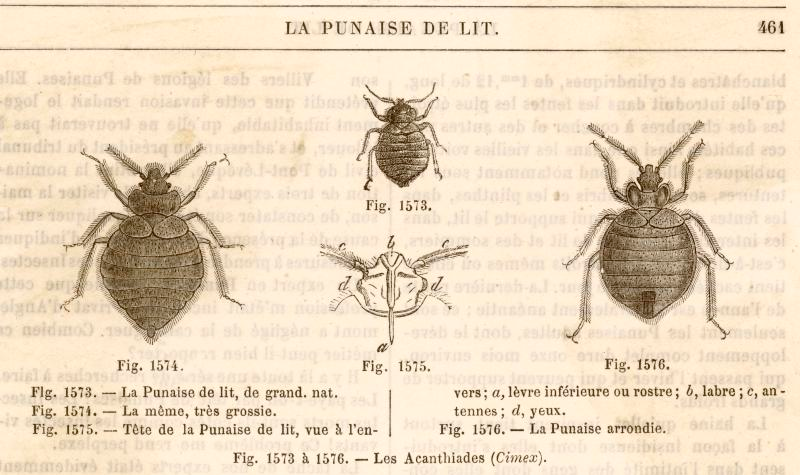Bed Bug Entomology
All about the life, behavior and appearance of Cimex lectularius, the common bed bug. Small and persistent insects that cause big problems.
From cave life to modern city life: a short bed bug history
It’s believed that humans first became associated with bed bugs thousands of years ago when people lived in caves. As human societies evolved and villages and cities began to form, the relationship between bed bugs and humans grew closer. By the 17th and 18th centuries, bed bugs were widespread across Europe and North America.
Their numbers declined in the mid-20th century due to the widespread use of pesticides like DDT. However, in recent decades, bed bugs have made a strong comeback, likely due to factors such as pesticide resistance, increased global travel, and the dense living conditions in modern cities.
What is a bed bug?
Bed bugs are small, parasitic insects classified in the family Cimicidae which feed exclusively on blood. Two species- the Common bed bug (Cimex lectularius), found in temperate climates, and the Tropical bed bug (Cimex hemipterus), found in tropical climates- feed almost exclusively on human blood…
What does a bed bug look like?
The adults can easily be seen with the naked eye.
Immature bed bugs are also visible to the naked eye, but the first stages are much smaller than adults and translucent yellow-white in colour…
Why have bed bugs been increasing?
Bed bugs started to increase in number since the early 2000s, and several factors contribute to this. A key factor is bed bugs growing resistance to common pesticides, making them harder to eliminate.
Another factor is…
How long distance can a bed bug walk?
Bed bugs have a tremendous ability to spread in buildings and hotels indicating a good walking ability. Typically they will stay as close to the food source as possible, but if few or no suitable harbourages are available or if a bed bug lose track of other bed bugs it may start a random search which may take it quite far…
What is a bed bug harbourage?
A bed bug harbourage is a location where bed bugs gather, hide, and rest when they’re not searching for food (blood). These areas are often marked by bed bug faeces, which indicates the presence of bed bugs…
Do bedbugs jump from person to person?
No! Bedbugs cannot jump from person to person like fleas do. Instead, they rely on other means of transportation such as crawling or hitchhiking on clothing, luggage, or other belongings…
Do bed bugs run from light?
Bedbugs are nocturnal creatures, meaning they are most active during the night and prefer darkness when feeding.
How long do bed bugs live?
Typically adults live for 2-4 months, but under favourable conditions they may live for longer times. At temperatures below 50°F (13°C) without frost, adults and 5th instars can survive up to a year without feeding.
Are bed bugs cannibals?
Bed bugs are not known to be cannibals.
Studies found no evidence of bed bugs eating each other, even under starvation conditions.
Which life stages do bed bugs go through?
Bed bugs go through five nymph stages before becoming adults. After hatching from eggs, bed bug nymphs moult five times…
How do bed bugs reproduce?
Bed bugs reproduce through a process called traumatic insemination, Males pierce the female’s abdomen with their needle-like genitalia and inject sperm. The sperm is stored in the female’s body and fertilizes the eggs as they are ready to be laid…
Can bed bugs fly?
No, bed bugs cannot fly; they can only crawl (quite quickly…). and are quite adept at hitching rides on clothing, luggage, or other items to infest new areas.
Can bed bugs survive the winter in a summer house?
Yes, if the summer house is kept above freezing, bed bugs can survive for several months in an inactive state…
Do bed bugs hibernate?
No, but at temperatures below 50°F (13°C), they become inactive and can remain in this state for months until the temperature rises and a blood meal becomes available…
At what temperature do bed bugs become inactive/enter dormancy?
Bed bugs typically enter a state of inactivity when temperatures drop below 50°F (13°C)…
Bed bug entomology
Bed bugs have been associated with humans for thousands of years, dating back to when people lived in caves. By the 17th and 18th centuries, they had spread across Europe and North America. Although their numbers decreased in the mid-20th century due to pesticides like DDT, bed bugs have resurged in recent decades, likely due to pesticide resistance, increased global travel, and urban living conditions.
Adult bed bugs are reddish-brown, about the size of an apple seed, and live exclusively on blood. They hide in cracks and crevices during the day, feeding at night. Bed bugs are poor fliers and typically spread by hitchhiking on luggage, clothing, or secondhand furniture. Their resurgence is attributed to resistance to pesticides, increased travel, and lack of awareness of control methods.
Bed bugs are nocturnal and prefer dark, undisturbed places to hide. They reproduce through traumatic insemination, and their life cycle involves five nymph stages before reaching adulthood. While they do not fly or jump, bed bugs can travel significant distances in search of a host.
